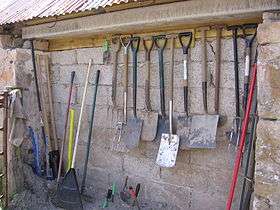Garden tool
A garden tool is any one of many tools made for gardening and overlaps with the range of tools made for agriculture and horticulture. Garden tools can be divided into hand tools and power tools.

Hand tools

The hand tools still used by gardeners originated with the earliest agricultural implements used by humans. Examples include: hatchet, axe, sickle, scythe, pitchfork, spade, shovel, trowel, hoe, fork, and rake. In some places, the machete may be used as a garden tool as well.
The earliest tools were made of wood, flint, metal, tin, and bone. However, the development of metal working, first in copper and later in iron and steel, enabled the manufacture of more durable tools. Industrial metalworking enabled the manufacture of efficient cutting tools including pruning shears (secateurs – for example anvil pruning shears), grass shears, and loppers.
In present days the gardening tools are made from light materials and are easy to handle. Different tools may vary in size depending on their use and brand.
Ergonomics
Modern tool design includes ergonomics considerations, which means that they are being designed to induce less stress on the human body when used. The most efficient tools keep the body in a neutral position to help reduce the stress on joints and muscles. An advantage of this approach is it requires gardeners to exert less energy whilst using the tools. Some modern patents like US 7,832,125 show an example without hand stop provisions.
Power tools
The first power tool to become popular with gardeners was the lawn mower. This has been followed by a very wide range of power tools, including: cultivators, string trimmers, irrigation sprinklers, hedge trimmers, lawn aerators, lawn sweepers, trenchers, leaf blowers, chainsaws, and mini-tractors.
Environmental impact
The exhaust fumes from gas-powered equipment is a significant source of air pollution.[1] US emission standards specifically limit emissions from these small engines.
See also
- Agricultural machinery
- Antique tool
- Cutting tool
- Diamond tool
- Groundskeeping equipment
- Landscape products
- Mechanised agriculture
- Tool